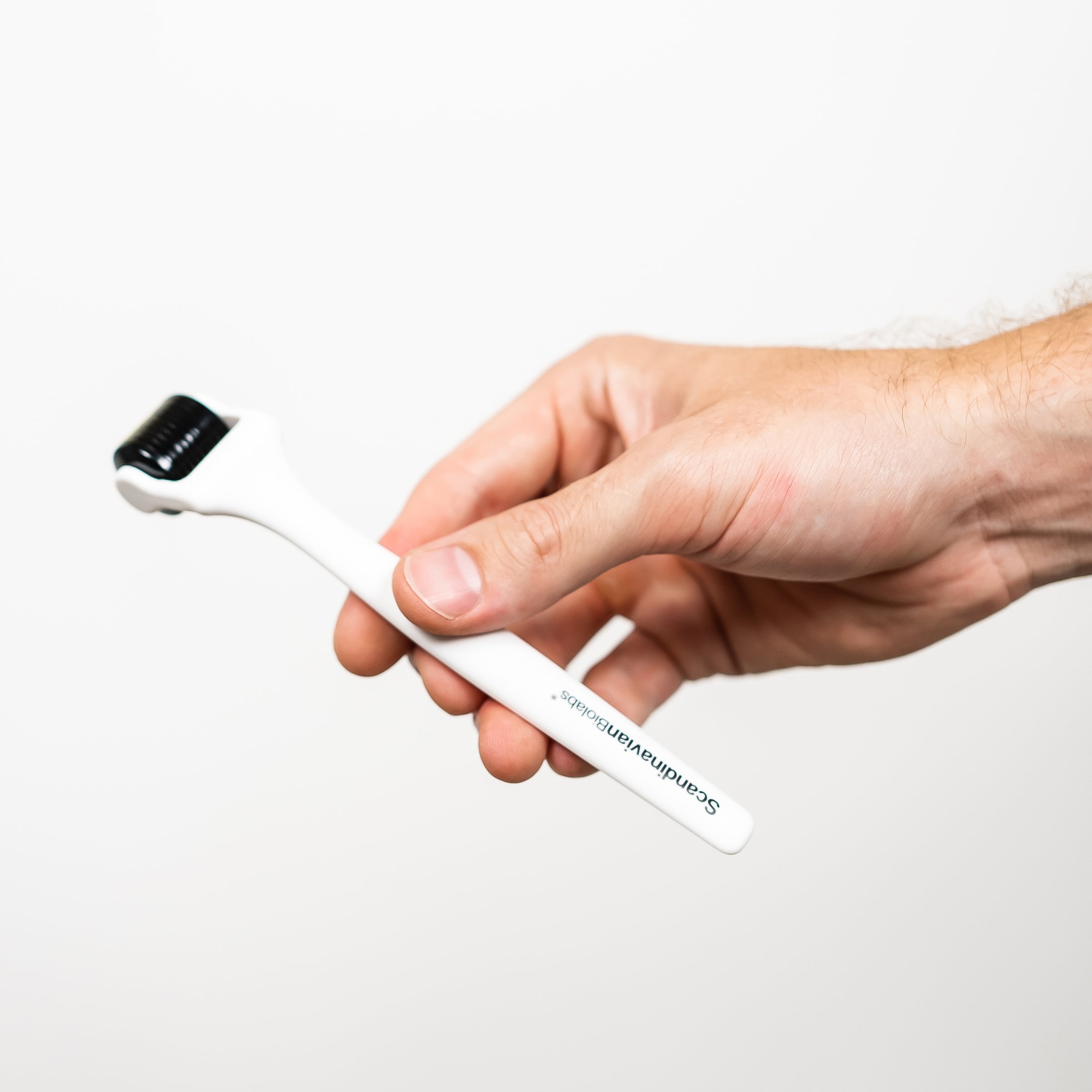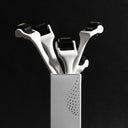If you're considering using minoxidil with dermaroller to stimulate hair growth, you're probably also wondering if it's worth the investment.
In this post, we'll take a closer look at how minoxidil and dermaroller work and share some of the pros and cons of using one.
You will better understand whether you should use best dermaroller with minoxidil, and what other options are there?
Table of content
What is derma rolling?
Derma rolling, or micro-needling, is a hair growth therapy that uses a small tool with fine needles to create microscopic puncture wounds in the scalp, triggering the body's natural healing process and promoting hair growth.
Derma rolling involves moving a derma roller, which has needles ranging from 0.25 to 1.5 mm in length, across your scalp.
This treatment has shown effectiveness in treating various types of hair loss, including pattern hair loss, alopecia areata, and telogen effluvium, particularly when combined with topical treatments.
Studies have demonstrated improved hair growth after 3-6 months of consistent use. For instance, a 2019 study on 50 patients with androgenetic alopecia and telogen effluvium reported partial or complete hair loss reduction and increased hair density and thickness after six months of micro-needling sessions.
Another study in 2020 on 52 patients with alopecia areata found a significant increase in hair follicles and hair length after 12 weeks of treatment.
As your leading source for hair health information over the past 4 years, we never compromise on accuracy. When it comes to your health, you deserve information you can truly rely on - and earning your trust is our top priority.
Here's how Scandinavian Biolabs ensures every piece of content meets the highest standards of accuracy and integrity:
- Credentialed Experts: Our reviewers are actively practicing doctors and medical researchers
- Stringent Reviews: Content undergoes rigorous editing by subject specialists and review by a practicing doctor.
- Evidence-Based: We rely on well-established research from trusted scientific sources like peer-reviewed journals and health authorities.
- Full Transparency: Our editorial standards, writer credentials, reviewer credentials, correction process, and funding are all publicly documented.
- Independent Voice: While we do promote products, we operate in a vacuum to business operations. Our main goal is just an unwavering commitment to providing medically-sound guidance.
You can count on Scandinavian Biolabs to consistently deliver the trustworthy health information you deserve. Read our Editorial Standards.
How does the derma roller work?
The derma roller creates small wounds that, although tiny and often not drawing blood, stimulate the body's healing response. This process enhances local collagen production, improves cell proliferation in hair follicles, and activates stem cells in the hair bulge, leading to natural hair growth improvement.
By promoting these biological responses, derma rolling can effectively support hair regrowth and improve hair thickness and density over time.
What is Minoxidil?
Minoxidil is a widely used and effective hair growth treatment, available in various forms such as topical solutions, shampoos, and oral medications. It's known for its safety and is commonly prescribed by hair loss experts.
Minoxidil is sold under the brand name Regaine in the UK and Rogaine in the US. It has been clinically proven to be effective, with a 2017 meta-analysis showing significant hair growth in both men and women with androgenetic alopecia.
Women using 2% Minoxidil saw an average increase of 12.41 hairs/cm², while men experienced increases of 8.11 hairs/cm² with 2% Minoxidil and 14.94 hairs/cm² with 5% Minoxidil compared to placebo.
This medication is also effective for various types of alopecia, including alopecia areata, traction alopecia, chemotherapy-induced hair loss, and telogen effluvium.
Unlike other hair growth treatments like Finasteride, Minoxidil can be safely used by both men and women, though it's always advisable to consult a dermatologist before starting treatment.
How does Minoxidil work?
Minoxidil works by dilating blood vessels in the scalp, thereby increasing the delivery of nutrients to hair follicles, which promotes hair growth. For best results, especially with the topical solution, apply Minoxidil to the affected areas of the scalp twice daily, morning and evening.
Women are generally advised to apply it once a day due to potential side effects. Gently massaging the solution into the scalp ensures better absorption and effectiveness.
Can you use minoxidil with a derma roller?
Using a derma roller with Minoxidil can enhance your results, as combining these therapies yields superior effects compared to using either alone.
Studies have shown that this combination is highly effective. In a study with 100 participants experiencing androgenetic alopecia, 82% of those who used both Minoxidil and derma rolling showed over 50% hair growth improvement, compared to just 4.5% using Minoxidil alone.
Another trial involving 50 patients found that 92% of those treated with both Minoxidil and monthly micro-needling sessions achieved moderate or excellent improvement, compared to 48% with Minoxidil only.
A meta-analysis of eight randomized control trials further confirmed significant hair count increases in those treated with both therapies.
These findings highlight the potential for enhanced hair growth when combining Minoxidil with derma rolling.
How to use a dermaroller with minoxidil?
In short, to use dermaroller with minoxidil, first, cleanse the scalp and dry it completely. Then, apply minoxidil to the scalp and allow it to dry.
Next, roll the dermaroller over the treated area in a criss-cross pattern, applying light pressure. Repeat this process once a week.
Here are six detailed steps you can take to ensure your minoxidil dermarolling experience:
- Make sure that your scalp is clean and dry.
- Take the dermaroller and carefully roll it over your scalp in different directions. Be sure to go slowly and not press too hard, as this irritates you. After you have rolled the dermaroller over your scalp, apply a generous amount of minoxidil (here's how much) to your head and massage it in. then, wash your hands thoroughly.
- Wait for the minoxidil to dry before applying it to your scalp.
- Once the minoxidil is dry, apply a generous amount of conditioner to your head and massage it.
- Rinse your head with cold water.
- Use a towel to dry your hair and style as usual.
- Repeat the dermaroller use once every two days for the best results.
How to choose the best dermaroller?
If there's anything that you should buy high-end, it's a dermaroller.
After all, the needles will penetrate your scalp, so you want something that's made out of good materials that won't cause any nasty infection.
The shape of the dermaroller is also important, as well-thought-out designs will allow you to easily and completely dermaroll your scalp, ensuring even hair growth.
Lastly, the material should be durable. Dermaroller isn't disposable, so opting for high-quality ones that last a lifetime is better for your wallet, your hair growth and the environment than cheap ones that snap in half or deteriorate.
You can of course spend hours on end researching for one that has all those features, or you can instantly get a luxurious-feeling dermaroller delivered to your doorsteps.
How often should you use a dermaroller for hair loss?

For best results, use a dermaroller every other day. Using it too frequently can damage the skin and cause inflammation, potentially leading to hair loss. Allowing time for recovery between sessions is crucial for effective results.
Side effects of dermarolling
And like anything else in life, dermarolling comes with a few potential side effects.
The most common is temporary redness, swelling, and skin bruising. This is usually nothing to worry about and will go away within a day or two.
Other possible side effects include infection, scarring, and hyperpigmentation.
However, these are relatively rare and can generally be avoided by taking proper skin care before and after dermarolling.
In short, dermarolling is safe for most people when done correctly.
If you're in doubt, be sure to consult with a doctor or dermatologist before getting started.
Alternative treatments to dermarolling

As an alternative to dermarolling, finasteride can be used to help improve the effectiveness of minoxidil. Finasteride is a prescription medication that is typically used to treat hair loss.
Studies have shown that combined use of minoxidil and finasteride are more effective when used together.
Is it safe to use minoxidil after dermaroller?
It is generally safe to use minoxidil after dermaroller, but it is important to wait at least 24 hours after dermarolling before applying minoxidil to avoid any potential irritation.
When to use minoxidil after dermaroller?
It is recommended to wait at least 24 hours after dermarolling before applying minoxidil to avoid any potential irritation.
Should you derma roll before or after minoxidil?
It's most common to derma roll before using Minoxidil, as the tiny puncture wounds created by the derma roller increase the absorption of the topical medication, allowing it to enter the bloodstream faster and in larger quantities, thereby enhancing its effect.
Conclusion
Using Minoxidil with a derma roller can significantly enhance hair growth results. By understanding how these treatments work individually and together, you can make an informed decision about incorporating them into your hair care routine.
Always consult with a healthcare professional to ensure the best approach for your specific needs and to avoid potential side effects.
With proper usage and moderation, these combined therapies can help you achieve a fuller, healthier head of hair.
References
- https://pubmed.ncbi.nlm.nih.gov/12196747/
- https://pubmed.ncbi.nlm.nih.gov/31499158/
- https://www.ncbi.nlm.nih.gov/pmc/articles/PMC7759057/
- https://www.sciencedirect.com/science/article/abs/pii/S0190962217303067
- http://journal11.magtechjournal.com/Jwk_jcyxylc/EN/Y2021/V41/I3/393
- https://onlinelibrary.wiley.com/doi/abs/10.1111/jocd.13061
- https://pubmed.ncbi.nlm.nih.gov/29194786/
- https://onlinelibrary.wiley.com/doi/abs/10.1111/jocd.14743







